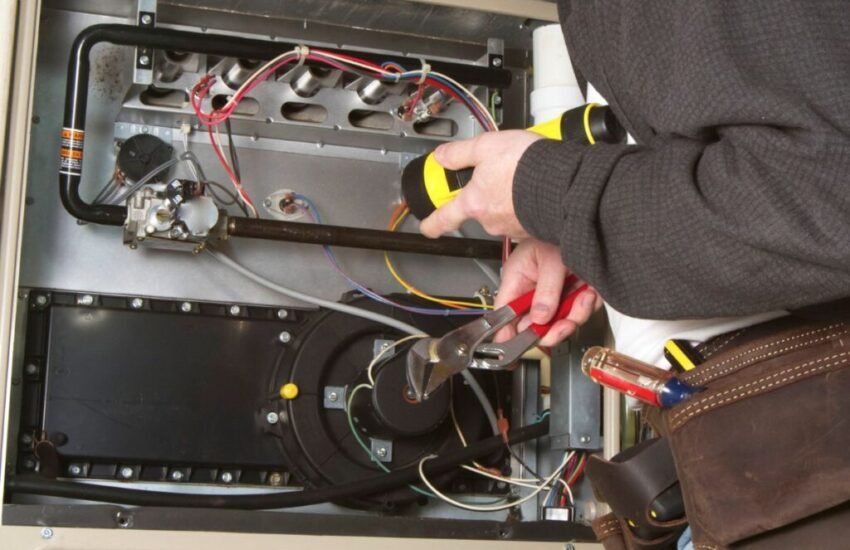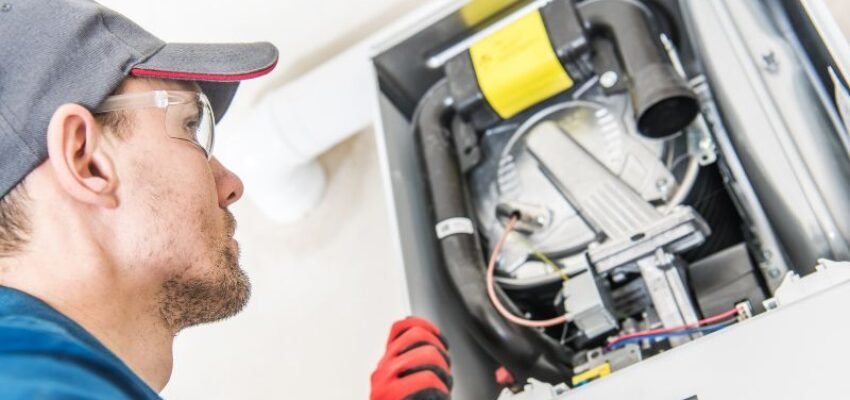
Published November 17, 2023
Is your furnace fan refusing to help keep your home warm? This issue can be pretty frustrating, especially during the colder months. However, you’re not alone, and there are several possible reasons why your furnace fan might not be working. In this article, we’ll explore over ten potential causes for this problem.
Different Types of Furnaces
Gas Furnaces
Arguably the most common type of furnace, gas furnaces are known for their efficiency and cost-effectiveness. They burn natural gas to produce heat, distributing it throughout your home via ductwork. These furnaces are ideal for colder climates and areas where gas is readily available and relatively cheap.
Oil Furnaces
While not as efficient as gas furnaces, oil furnaces are viable in areas where natural gas isn’t easily accessible. They operate by burning heating oil, which you must have delivered and stored on your property. Although they can provide ample heat, the cost of oil can fluctuate, impacting your heating costs.
Electric Furnaces
Electric furnaces are an excellent choice for milder climates where the demand for heat isn’t as high. They use electric heating elements to generate heat, making them safer and cleaner than gas or oil furnaces. However, they can be more expensive to operate due to the high cost of electricity.
Propane Furnaces
Like oil furnaces, propane furnaces are often used in areas where natural gas isn’t available. They burn propane to create heat, so you must store a propane tank on your property. While propane is typically more expensive than natural gas, these furnaces can be a good choice if other fuel sources aren’t available.
Heat Pump Furnaces
Heat pump furnaces are unique because they can both heat and cool your home. They work by transferring heat from one place to another rather than generating it, making them highly efficient. They can run on electricity or gas and are best suited for moderate climates.
Dual Fuel Furnaces
Dual fuel furnaces combine a heat pump’s efficiency with a gas furnace’s power. They use the heat pump in milder weather and switch to the gas furnace when temperatures drop, providing energy-efficient heat all year round.
Modulating Furnaces
Modulating furnaces are designed to provide precise temperature control. They adjust the fuel burned to closely match your home’s heating needs, resulting in consistent comfort and improved efficiency.
Reasons Why Your Furnace Fan is Not Working
1. Thermostat Issues
The first place to check is your thermostat. It controls the furnace and, by extension, the fan. If it’s incorrectly set or malfunctioning, it could be the reason your furnace fan isn’t kicking in.
2. Power Supply Problems
If your furnace fan isn’t receiving power, it won’t work. Check your circuit breaker to see if it has tripped. If so, resetting it might solve the problem. However, if the issue persists, you may have a more severe electrical issue that requires professional attention.
3. Motor Failure
Just like any other mechanical device, the motor in your furnace fan can fail due to wear and tear. If the engine isn’t running, the fan won’t spin, leaving you with a cold house.
4. Faulty Fan Limit Switch
The fan limit switch controls when the fan turns on and off. If it’s faulty, it might not turn the fan on even when the furnace is hot, causing the heat not to circulate.
5. Dirty Air Filters
Dirty air filters block airflow, causing the furnace to overheat and shut off as a safety measure. Regularly changing your filters can prevent this.
6. Issues with the Control Board
The furnace’s control board manages all its functions. If it’s malfunctioning, it could cause the fan not to work.
7. Broken Belts
If the belt connecting the motor to the fan is broken, the fan won’t spin. Fortunately, this is a simple fix involving replacing the belt.
8. Capacitor Problems
The capacitor provides the initial jolt to start the motor. If it’s defective, the engine might not start, so that the fan won’t work.
9. Blower Assembly Issues
A problem with the blower assembly, such as a blockage or damage, can prevent the fan from working correctly.
10. Faulty Wiring
Faulty or loose wiring can disrupt the power supply to the fan, causing it to malfunction.
11. Issues with the Fan Relay
The fan relay controls the power to the fan. It might not send power to the fan if it is faulty, causing it not to run.
12. Circuit Breaker
If the circuit breaker is tripped or a fuse is blown, the furnace blower may not work.

Frequently Asked Questions (FAQs)
How do you reset a furnace fan?
To reset a furnace fan, turn off the circuit breaker’s power. Wait a few minutes, then turn it back on. Next, locate the reset button on your furnace (usually red and near the motor housing). Press and hold the button for 30 seconds. If this doesn’t work, call a professional.
How much does it cost to fix a furnace fan?
The cost to fix a furnace fan, specifically the blower motor, varies. The cost of parts can range from $70 to $1,000. Labor costs can range from $150 to $410. Therefore, the total cost can be between $220 and $1,410. These costs can vary based on your location and specific furnace model.
Can a furnace work without a fan?
A furnace can technically operate without a fan, but it’s not advisable. The fan, or blower, circulates warm air throughout your home. Without it, the heat would just build up in the furnace and not distribute, which could lead to overheating and potential damage to the furnace system.
Wrapping it up
Remember, while some of these issues can be fixed with a simple DIY approach, others require professional attention. If you’re unsure what’s causing your furnace fan not to work, it’s best to call a heating professional to diagnose and fix the problem.
Don’t let a faulty furnace fan leave you in the cold. Understanding these common issues can help you troubleshoot more effectively and ensure you get your furnace back up and running quickly.
